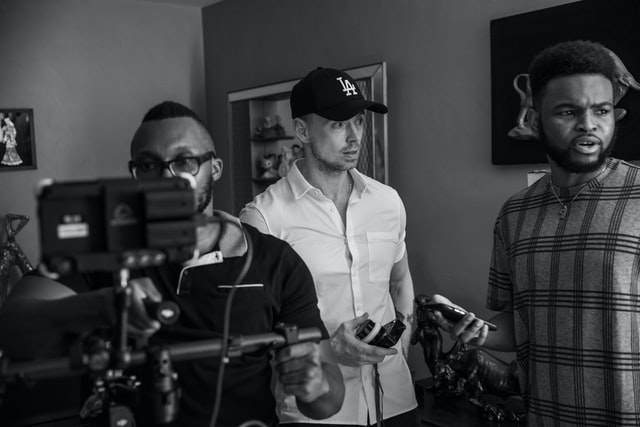Did you enjoy this video? Looking for more video filming tips to apply on your small business videos? Click this link for more details.
Video Transcript: There are three types of video basically that we’re going to go through. There’s live video, which we’re recording today and generally you’ll be doing most of that. There’s screen capture which is becoming more and more prevalent, it’s fantastic, I love screen capture and I’ll talk about that. Also then there are slides, turning an audio podcast into a video through PowerPoint presentations.
This is my golden rule for when you’re presenting or doing a film shoot or a video shoot of any kind. There is a lot to remember, there is a lot to do, so the five Ps, you might have heard of this, it’s Proper Preparation Prevents Poor Performance. Say it with me. It’s true, it’s like with the scripts. You write a clear script, you have a clear structure, then that’s going to help you out.
For some reason, as soon as you involve a camera, things start to go wrong. Especially when you’re shooting outside and you’re shooting in daylight and a cloud goes over. Or it’s cloudy and the sun comes out or a light goes out or you run out of batteries, there are so many things that can go wrong. So it’s good to be prepared.
This is just a bit of an aside, but if you’re filming people for your online video marketing business, if you’re asking them to be on camera, much like we’ve done with you today, ask them to sign a release form. We’ve included it at the back of the manual, just a basic one that we use. It’s a legal thing to do so that people can agree to be on camera in some way.
So here’s the check list I’m going to go through: the camera, audio and the lighting and just so you know what to follow each time. The first thing is with your camera, so we’re doing this as if we’re presenting to the camera. I’ve set it up here so you guys can see me, I’ll bring this forward for now.
Just really quickly, the angle on which you have your camera gives a certain meaning. If the camera is pointed up like this and you’re looking down into it, that’s going to convey a different meaning to if you’re looking up into a camera. We as humans read things differently in that respect. So if you’re looking down into the camera, you’re the authority, you’re standing over it, you’re like, this is what you need to do, basically that’s the kind of feeling you get from it.
If you’re looking up at the camera as opposed to looking down the camera, you’re looking up at the camera, cinematographers use this kind of technique of making someone look a bit smaller or belittled or lower than something.
Generally you won’t want to use either of those. You want the camera to just be even with you, with your eye. It comes back to whether you’re sitting or standing. If you’re sitting, you just need to set it up at eye level. If you’re standing, you need your tripod, video production equipment or a box or whatever you can, get McGyver on this type of thing to set the camera at a decent height. It really does make a big difference.
David: The way I like to set the level as well, depending on what it is that you’re trying to do, if you’re trying to feel like you’re talking from a stage, so it’s like you’re presenting, then you might have the angle slightly up, so it’s like you’re talking down. Sometimes if I’m trying to do a one on one type, meet Dave, I’ll do it at the same level, they’re on the same level as me. If I want to go up here, then it’s one of those dodgy Myspace photos. It really depends on what it is you’re trying to get across.
Ben: Yes and if you’re doing it from your computer, often because the camera will be at the top, you will be looking up a little bit more. So the way to counteract that, if you’ve got a Mac you can tilt it down and maybe if you can, sit a bit further back, it will start to balance it out a bit. So that’s in terms of height, what you want to get across.
Distance as well. Cameras have zooms, the Flips and things have limited zooms, so you just want to be at a good distance from the camera where, we’ll talk about this in a sec, the frame, where you appear in the camera has a certain amount of meaning as well.
So if you’re doing this style, Dave’s style of presenting to the camera, we put the camera as far back as we can because we’re in a small room and then you just find the right distance so you appear in a certain level.
Now what you want, I’ll talk about framing now and other home recording tips, framing is obviously what appears in the frame of the camera. There are many different techniques. I find the best one to use for this technique is similar to what I showed you, maybe the second and third videos I showed you in the evolution of Dave’s section, is you want to stand left or right of the camera in one third of it.
Standing in the center is a bit flat. It feels like it should be the natural thing to do but if you watch most films and TV shows and things like that, it very rarely happens. It might if they’re going for a very symmetrical shot or something like that, that’s when they’ll use it, but generally, if you’re off center a bit, it’s just more pleasing. There’s just something more pleasing about it to the eye.
Now you know these video filming tips and other hints on how to improve the quality of your videos. Want to get help in producing and marketing your own business videos? Contact our video filming experts today.





